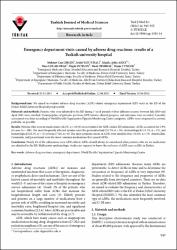Emergency department visits caused by adverse drug reactions: results of a Turkish university hospital

Göster/
Erişim
info:eu-repo/semantics/openAccessTarih
2016Yazar
Girgin, Mehmet CanYanturalı, Sedat
Arıcı, Mualla Aylin
Çolak Oray, Neşe
Doylan, Özgür
Demiral, Yücel
Tunçok, Yeşim
Üst veri
Tüm öğe kaydını gösterÖzet
Background/aim: We aimed to evaluate adverse drug reaction (ADR)-related emergency department (ED) visits in the ED of the Dokuz Eylül University Hospital prospectively. Materials and methods: Patients who were admitted to the ED during 1-week periods of four different seasons between July 2010 and April 2011 were enrolled. Demographics of patients, previous ADR history, clinical progress, and outcomes were recorded. Causality assessment was done according to World Health Organization Uppsala Monitoring Centre categories. ADRs were categorized as certain, probable, or possible. Results: Patients who were on medications (26.5%, n = 1838) were evaluated for ADR-related ED admissions. ADRs accounted for 5.9% of cases (n = 108). The most frequently affected systems were the gastrointestinal (35.2%, n = 38), dermatological (23.1%, n = 25), and hematological (10.2%, n = 11) systems (7.4%, n = 8). The most common causes of ADRs were antiinfectives (31.6%, n = 33). Amoxicillin, Coumadin, and paracetamol were the most common medications that caused ADRs. Conclusion: Nearly 6% of the admissions were ADR-related. ADRs should always be considered when patients who are on medication are admitted to the ED. Multicenter epidemiologic studies are required to know the real rates of ADR cases in EDs in Turkey Background/aim: We aimed to evaluate adverse drug reaction (ADR)-related emergency department (ED) visits in the ED of the Dokuz Eylül University Hospital prospectively. Materials and methods: Patients who were admitted to the ED during 1-week periods of four different seasons between July 2010 and April 2011 were enrolled. Demographics of patients, previous ADR history, clinical progress, and outcomes were recorded. Causality assessment was done according to World Health Organization Uppsala Monitoring Centre categories. ADRs were categorized as certain, probable, or possible. Results: Patients who were on medications (26.5%, n = 1838) were evaluated for ADR-related ED admissions. ADRs accounted for 5.9% of cases (n = 108). The most frequently affected systems were the gastrointestinal (35.2%, n = 38), dermatological (23.1%, n = 25), and hematological (10.2%, n = 11) systems (7.4%, n = 8). The most common causes of ADRs were antiinfectives (31.6%, n = 33). Amoxicillin, Coumadin, and paracetamol were the most common medications that caused ADRs. Conclusion: Nearly 6% of the admissions were ADR-related. ADRs should always be considered when patients who are on medication are admitted to the ED. Multicenter epidemiologic studies are required to know the real rates of ADR cases in EDs in Turkey

















